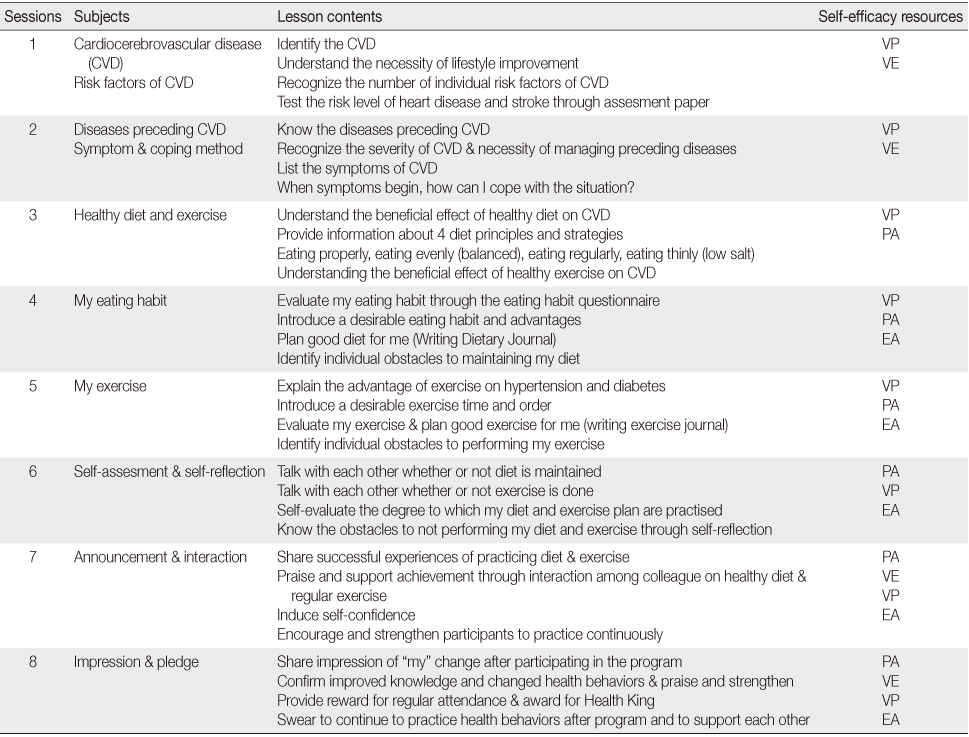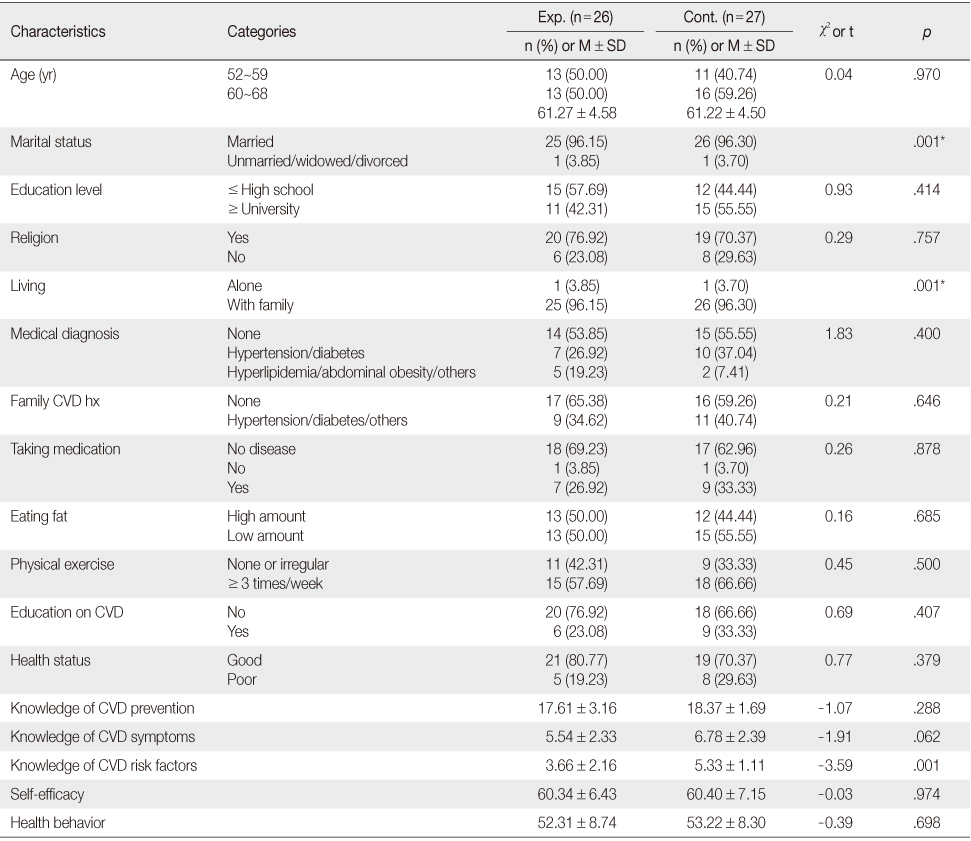Articles
- Page Path
- HOME > J Korean Acad Nurs > Volume 45(1); 2015 > Article
-
Original Article
- Effects of a Cardiocerebrovascular Disease Prevention Education Program for Postmenopausal Middle-aged Women
- Soo Kyung Choi, In Sook Kim
-
Journal of Korean Academy of Nursing 2015;45(1):25-34.
DOI: https://doi.org/10.4040/jkan.2015.45.1.25
Published online: February 27, 2015
1Department of Nursing, Christian College of Nursing, Gwangju, Korea.
2Department of Nursing, Chosun University, Gwangju, Korea.
- Address reprint requests to: Kim, In Sook. Department of Nursing, Chosun University, 375 Seosuk-dong, Dong-gu, Gwangju 501-759, Korea. Tel: +82-62-230-6321, Fax: +82-62-230-6329, isakim@chosun.ac.kr
© 2015 Korean Society of Nursing Science
This is an Open Access article distributed under the terms of the Creative Commons Attribution NoDerivs License. (http://creativecommons.org/licenses/by-nd/4.0/) If the original work is properly cited and retained without any modification or reproduction, it can be used and re-distributed in any format and medium.
Abstract
-
Purpose
- This study was conducted to examine effects of a cardiocerebrovascular disease (CVD) prevention education program on knowledge, self-efficacy and health behavior among postmenopausal middle-aged women.
-
Methods
- A non-equivalent control group pretest-posttest design was used. Participants were 53 postmenopausal middle-aged women who registered in two community culture centers in G metropolitan city. Experimental group (n=26) received a CVD prevention education program 8 times over 8 weeks. Knowledge, self-efficacy and health behavior of the participants were examined with self-report structured questionaries. Data were collected between October 15 and December 11, 2013, and were analyzed using chi-square test, Fisher's exact test, independent t-test, and analysis of covariance with SPSS/PC version 21.0.
-
Results
- After the intervention the experimental group showed significant increases in the knowledge of CVD symptoms (p<.001) and CVD risk factors (p<.001), level of self-efficacy (p=.028) and health behavior (p<.001) compared to the control group. However, no significant difference was found between groups for knowledge of CVD prevention (p<.133).
-
Conclusion
- Results suggest that a CVD prevention education program can be an effective strategy to improve knowledge on CVD symptoms and risk factors, self-efficacy and health behavior for postmenopausal middle-aged women.
- 1. Park HK. National cardiovascular disease preventive management strategies. In: Paper presented at: Korean cardiology-related societies joint scientific session & The pulse of Asia 2013 Seoul. 2013 April 19-20; Hilton Hotel. Seoul, The Korean Society of Cardiology.
- 2. Statistics Korea. 2012 annual report on the causes of death statistics [Internet]. Daejeon, Author. 2013;cited 2013 May 15. Available from: http://kostat.go.kr/portal/korea/kor_nw/2/1/index.board?bmode=read&aSeq=308559
- 3. World Health Organization. United Nations high-level meeting on noncommunicable disease prevention and control: NCD summit to shape the international agenda. New York, NY, Author. 2011;cited 2013 May 15. Available from: http://www.who.int/nmh/events/un_ncd_summit2011/en/
- 4. Stirrat C, Mann S. Perceptions of cardiovascular risk factors among cardiology outpatients. Heart Lung Circ. 2008;17:Suppl 2. S22–S23. Article
- 5. World Health Organization. Preventing chronic diseases: A vital investment. WHO Global Report. Geneva, CH: Author; 2005.
- 6. Health Insurance Review & Assessment Service. Disclosure of cardiocerebrovascular disease evaluation results [Internet]. Seoul, Author. 2012;cited 2013 May 15. Available from: http://www.hira.or.kr/dummy.do?pgmid=HIRAA020041000000&cmsurl=/cms/notice/02/1214308_13390.html
- 7. American Heart Association. Warning signs of heart attack, stroke & cardiac arrest [Internet]. Dallas, TX, Author. 2013;cited 2013 May 15. Available from: http://www.heart.org/HEARTORG/Conditions/911-Warnings-Signs-of-a-Heart-Attack_UCM_305346_SubHomePage.jsp
- 8. Kirchberger I, Heier M, Kuch B, Wende R, Meisinger C. Sex differences in patient-reported symptoms associated with myocardial infarction (from the population-based MONICA/KORA Myocardial Infarction Registry). Am J Cardiol. 2011;107(11):1585–1589. ArticlePubMed
- 9. Women's cardiovascular health. An official position statement of the Association of Women's Health, Obstetric & Neonatal Nursing. J Obstet Gynecol Neonatal Nurs. 2011;40(5):662–664. PubMed
- 10. Lloyd-Jones D, Adams RJ, Brown TM, Carnethon M, Dai S, De Simone G, et al. Heart disease and stroke statistics-2010 update: A report from the American Heart Association. Circulation. 2010;121(7):e46–e215. PubMed
- 11. Lisabeth LD, Brown DL, Hughes R, Majersik JJ, Morgenstern LB. Acute stroke symptoms: Comparing women and men. Stroke. 2009;40(6):2031–2036. ArticlePubMed
- 12. Worrall-Carter L, Ski C, Scruth E, Campbell M, Page K. Systematic review of cardiovascular disease in women: Assessing the risk. Nurs Health Sci. 2011;13(4):529–535. ArticlePubMed
- 13. Korea Centers for Disease Control and Prevention. Surveillance and quality management of out-of-hospital cardiac arrest [Internet]. Cheongju, Author. 2011;cited 2013 May 13. Available from: http://www.cdc.go.kr/CDC/info/CdcKrInfo0201.jsp?menuIds=HOME001-MNU1155-MNU1083-MNU1375-MNU0025&cid=1583
- 14. Innes KE, Selfe TK, Taylor AG. Menopause, the metabolic syndrome, and mind-body therapies. Menopause. 2008;15(5):1005–1013. ArticlePubMedPMC
- 15. Korea Centers for Disease Control and Prevention. In-depth analyses of the third national Health and nutrition examination survey (KNHANES III): Health examination [Internet]. Cheongju, Author. 2007;cited 2013 May 13. Available from: http://www.cdc.go.kr/CDC/info/CdcKrInfo0201.jsp?menuIds=HOME001-MNU1155-MNU1083-MNU1375-MNU0025&cid=1219
- 16. Gu MO, Yu JS, Kweon IK, Kim HW, Lee EO. A review of research on self efficacy theory applied to health related behavior. J Nurs Acad Soc. 1994;24(2):278–302.ArticlePDF
- 17. Bandura A. Self-efficacy mechanism in human agency. Am Psychol. 1982;37(2):122–147.Article
- 18. Kim EY, Hwang SY. Development and evaluation of a small group-based cardiocerebrovascular disease prevention education program for male bus drivers. J Korean Acad Nurs. 2012;42(3):322–332. ArticlePubMed
- 19. Park HJ. The effects of lifestyle modification education program on the workers' knowledge, attitude and behavior to prevent cerebrocardiovascular diseases in middle and small-sized industries [master's thesis]. Seoul, Dongguk University. 2008.
- 20. Lee HJ. Development and evaluation of community education program for cardiocerebrovascular high-risk patients [dissertation]. Daegu, Kyungpook National University. 2010.
- 21. Park MK, Kim JH. Effects of a comprehensive lifestyle improvement program for middle-aged women with cardio-cerebrovascular disease-related risk factors. J Korean Acad Community Health Nurs. 2013;24(2):111–122. Article
- 22. Chonnam National University Hospital Regional Cardiocerebrovascular Center. Education manual for patient and family [Internet]. Gwangju, Author. 2010;cited 2013 July 20. Available from: http://www.gjccvc.co.kr/sub.htm?PID=0605
- 23. Bandura A. Regulation of cognitive processes through perceived selfefficacy. Dev Psychol. 1989;25(5):729–735. Article
- 24. American Heart Association. Coronary artery disease: Coronary heart disease [Internet]. Dallas, TX, Author. 2013;cited 2013 May 13. Available from: http://www.heart.org/HEARTORG/Conditions/More/My-HeartandStrokeNews/Coronary-Artery-Disease---Coronary-Heart-Disease_UCM_436416_Article.jsp
- 25. Sherer M, Maddux JE, Mercandante B, Prentice-dunn S, Jacobs B, Rogers RW. The self-efficacy Scale: Construction and validation. Psychol Rep. 1982;51(2):663–671.ArticlePDF
- 26. Becker DM, Levine DM. Risk perception, knowledge, and lifestyles in siblings of people with premature coronary disease. Am J Prev Med. 1987;3(1):45–50.ArticlePubMed
- 27. Shin KR, Shin SJ, Kim JS, Kim JY. The effects of fall prevention program on knowledge, self-efficacy, and preventive activity related to fall, and depression of low-income elderly women. J Korean Acad Nurs. 2005;35(1):104–112.ArticlePDF
- 28. Song KJ. The effects of self-efficacy promoting cardiac rehabilitation program on self-efficacy, health behavior, and quality of life [dissertation]. Seoul, Seoul National University. 2001.
- 29. Song AR. Development of and educational program for the management of menopause and it's effect. J Korean Acad Nurs. 1998;28(2):280–290.ArticlePDF
- 30. Lowdermilk DL, Perry SE. Yoo EK Kim MH Kim SA Park SA Shin HS Ahn S . Maternity & women's health care. Seoul: Hyunmoon; 2005.
- 31. Shin HS, Lee J, Lee KH, Song YA. Health behavioral patterns associated with psychologic distress among middle-aged Korean women. Asian Nurs Res. 2007;1(1):61–67. Article
REFERENCES
Figure & Data
REFERENCES
Citations

- A Community-Based, Lifestyle Behavioral Intervention Based on the Extended Theory of Planned Behavior for Postmenopausal Women at Cardiometabolic Risk: A Randomized Controlled Trial
Sooyeon Park, Jina Choo
Western Journal of Nursing Research.2025; 47(7): 573. CrossRef - Factors Associated with Cardiovascular Health Behaviors in Younger and Older Adults with Schizophrenia Living in the Community in Korea: A Cross-Sectional Study
Seon Young Hwang, Yu Mi Song, Pil Hwa Heo, Sra Kim, Katherine Cahir, Heeyoung Lee
Clinical Gerontologist.2025; : 1. CrossRef - Mental Health Status of Adults with Cardiovascular or Metabolic Diseases by Gender
Yeunhee Kwak, Yoonjung Kim, Soo Jin Kwon, Haekyung Chung
International Journal of Environmental Research and Public Health.2021; 18(2): 514. CrossRef - Effects of a Daily Life-Based Physical Activity Enhancement Program for Middle-Aged Women at Risk for Cardiovascular Disease
Kyung Ae Kim, Seon Young Hwang
Journal of Korean Academy of Nursing.2019; 49(2): 113. CrossRef - Factors related to the Identification of Middle-Aged Women Who are Disadvantaged by Cardio-cerebrovascular Disease
Moon Jung Kang, Jee Seon Yi, Chang Seung Park
Korean Journal of Women Health Nursing.2018; 24(2): 185. CrossRef - Knowledge on Cardio-cerebrovascular Disease and Health Behaviors among Middle-aged Postmenopausal Women at Risk
Kyung Ae Kim, Seon Young Hwang
Korean Journal of Adult Nursing.2016; 28(4): 424. CrossRef
Learning Objectives and Lesson Contents of the CVD Prevention Education Program
VP=Verbal persuasion; VE=Vicarious experience; PA=Performance accomplishment; EA=Emotional arousal.
Homogeneity Test of Characteristics and Dependent Variables (N =53)
*Fisher's exact test; Exp.=Experimental group; Cont.=Control group; CVD=Cardiocerebrovascular disease; hx=History.
Comparison of Dependent Variables between Two Groups after Treatment (N =53)
Exp.=Experimental group (n=26); Cont.=Control group (n=27); CVD=Cardiocerebrovascular disease.
Analysis of Covariance (ANCOVA) for Knowledge of CVD Risk Factor (N =53)
Exp.=Experimental group; Cont.=Control group; CVD=Cardiocerebrovascular disease.
VP=Verbal persuasion; VE=Vicarious experience; PA=Performance accomplishment; EA=Emotional arousal.
*Fisher's exact test; Exp.=Experimental group; Cont.=Control group; CVD=Cardiocerebrovascular disease; hx=History.
Exp.=Experimental group (n=26); Cont.=Control group (n=27); CVD=Cardiocerebrovascular disease.
Exp.=Experimental group; Cont.=Control group; CVD=Cardiocerebrovascular disease.
 KSNS
KSNS
 E-SUBMISSION
E-SUBMISSION




 Cite
Cite

